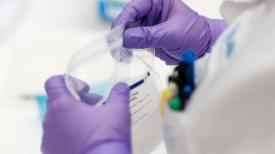- Cancer Care Team
Cancer Care Team
To deliver optimal patient outcomesProducts and Services
Cancer Type
Supplies & Tools
Scientific Focus
- Biopharma Partners
- Patients
- Education & Events
- Login
- Contact Us
CPT 81235; 88381
Synonyms
- Erlotinib Responsiveness in NSCLC, EGFR Mutation Analysis
- Non−Small-cell Lung Cancer, EGFR Mutation Analysis
- Osimertinib Responsiveness in NSCLC, EGFR Mutation Analysis
- Tagrisso® Responsiveness in NSCLC, EGFR Mutation Analysis
- Tarceva® Responsiveness in NSCLC, EGFR Mutation Analysis
Test Details
 Cancer Type
Cancer Type
Lung, Non-small cell lung cancer
 Technology Used
Technology Used
Molecular
 Turnaround Time
Turnaround Time
7 - 10 days
Use
The FDA approved cobas® EGFR Mutation Test v2 is a real-time PCR test for the qualitative detection of defined mutations in exons 18, 19, 20 and 21 of the epidermal growth factor receptor (EGFR) gene in non-small cell lung cancer (NSCLC) patients. Defined EGFR mutations are detected using DNA isolated from FFPE tumor tissue or circulating-free tumor DNA (cfDNA) from plasma derived from EDTA anticoagulated peripheral whole blood. The test is indicated as a companion diagnostic to aid in selecting NSCLC patients for treatment with the targeted therapies listed in the table below in accordance with the approved therapeutic product labeling:
Drug | FFPE | Plasma |
|---|---|---|
EGFR Tyrosine kinase Inhibitors approved by FDA* | Exon 19 deletions L858R | Exon 19 deletions, L858R |
• Additional indications in accordance with approved therapeutic product labeling
Drug | FFPE | Plasma |
|---|---|---|
Tagrisso™ (osimertinib) | Exon 19 deletions, T790M and L858R | Exon 19 deletions, T790M** and L858R |
*The efficacy of Tagrisso™ (osimertinib) has not been established in the EGFR T790M plasma-positive, tissue-negative or unknown population and clinical data for T790M plasma-positive patients are limited; therefore, testing using plasma specimens is most appropriate for consideration in patients from whom a tumor biopsy cannot be obtained.
**Visit https://www.fda.gov/medicaldevices/productsandmedicalprocedures/invitrodiagnostics/ucm301431.htm for the most current information about the therapeutic products in this group.
Drug safety and efficacy have not been established for the following EGFR mutations also detected by the cobas® EGFR Mutations Test v2:
Drug | FFPE | Plasma |
|---|---|---|
Tarceva® (erlotinib) | G719X, S768I, T790M, exon 20 insertions and L861Q | G719X, S768I, T790M, exon 20 insertions and L861Q |
Tagrisso™ (osimertinib) | G719X, S768I, exon 20 insertions and L861Q | G719X, S768I, exon 20 insertions and L861Q |
Iressa® (gefitinib) | G719X, S768I, T790M, exon 20 insertions and L861Q | G719X, S768I, T790M, exon 20 insertions and L861Q |
Special Instructions
Please provide a copy of the pathology report or related ICD10 code on the requisition. EGFR test will be delayed if the pathology report and clinical indications are not received. Please direct any questions regarding this test to customer service at 800-345-4363.
Limitations
Detection of mutation is dependent on sample integrity and the amount of amplifiable DNA present in the specimen. The methods used in this assay are highly selective and, depending on the total amount of DNA present, can detect at least 5% of mutant (with the exception of the 2240_2257del18 in exon 19, which is detected at >10%) in a background of wild-type genomic DNA. The cobas® EGFR test can detect mutations in EGFR exons 18, 19, 20, and 21 with ≤ 100 copies of mutant DNA per mL of plasma using the standard input of 25 μL of DNA stock per reaction well.
Methodology
Genomic DNA was isolated from the provided tumor specimen using the Cobas® DNA Sample Preparation Kit for FFPE specimen and Cobas® cfDNA Sample Preparation Kit for plasma. Mutation detection is achieved through real-time PCR analysis on Cobas® z480 analyzer. The Cobas® EGFR Mutation Test v2 detects the following mutations: exon 18 (G719X), exon 19 (deletions and complex mutations), exon 20 (S768I, T790M, insertions) and exon 21 (L858R, L861Q).
Specimen Requirements
Information on collection, storage, and volume
Specimen
Formalin-fixed, paraffin-embedded (FFPE) tissue block, slides or plasma, frozen
Volume
Formalin-fixed, paraffin-embedded tissue block or four unstained slides and one matching H&E-stained slide at 5 μM, or 4 mL frozen plasma
Minimum Volume
Two unstained slides at 5 μM and one matching H&E-stained slide or 2 mL frozen plasma
Container
Slides, blocks, or 4 mL BD® purple-top (K2 EDTA) tube. Collect three tubes of whole blood in accordance with the collection procedure specified below.
Storage Instructions
Blocks or slides: Room temperature. Stability of FFPE block specimens stored at 15°C to 30°C for 12 months after the date of collection has been confirmed.
Five-micron sections mounted on slides may be stored at 15°C to 30°C for 60 days.
Plasma, frozen. The plasma sample could be stored frozen, at <-70°C for 12 months.
Causes for Rejection
No tumor tissue present in the provided specimen; samples in which tumor cellularity is <10% after macrodissection; broken or stained slides; hemolyzed blood; plasma not frozen; plasma volume <2 mL per tube; leaking or broken tubes
Collection
Please label each final plasma collection tube with the word "Plasma". Testing will be delayed if the tube is not labeled properly.
Blood Collection
• Blood should be collected according to your laboratory's procedure for venipuncture using only a BD purple-top (K2 EDTA) 4-mL blood collection tube. Plasma preparation should be performed within four hours after blood is collected. Store, transport, and ship plasma at frozen condition only. The plasma sample can be stored frozen at ≤-70°C for up to 12 months.
• Note: Do not freeze whole blood samples.
Plasma Specimen Preparation
• Immediately following specimen collection, label all tubes with appropriate patient identification information (two patient identifiers, minimum).
• The brake setting of the Drucker 642e at LabCorp service center is at 3 or 4 (manufacturer setting).
• Centrifuge the three, BD purple-top (K2 EDTA) blood collection tubes for 10 minutes at 1600±90 rcf. For conversion of RPM (revolutions per minute) to rcf (relative centrifugal force), refer to the centrifuge manufacturer's user manual.
• Remove blood collection tubes from the centrifuge (Plasma sample will be rejected if it is hemolyzed. Patient will be contacted).
• Using a fresh six-inch disposable transfer pipette, transfer plasma from three, 4-mL blood collection tubes to one 7.0-mL Sarstedt screw-cap, flat-bottom purple frozen transport tube (62.550.019). One 7.0-mL tube will be submitted.
• Ship and store plasma at ≤-70°C. Stable for 12 months.
• Note: Take care not to disturb or transfer the buffy coat (white blood cells) layered above the red blood cells in the blood collection tube after the centrifugation.
Related Tests
Find more tests related to this one.





